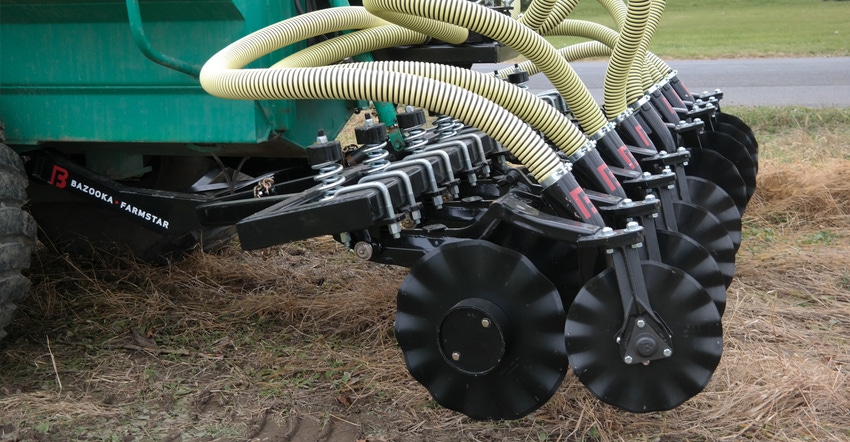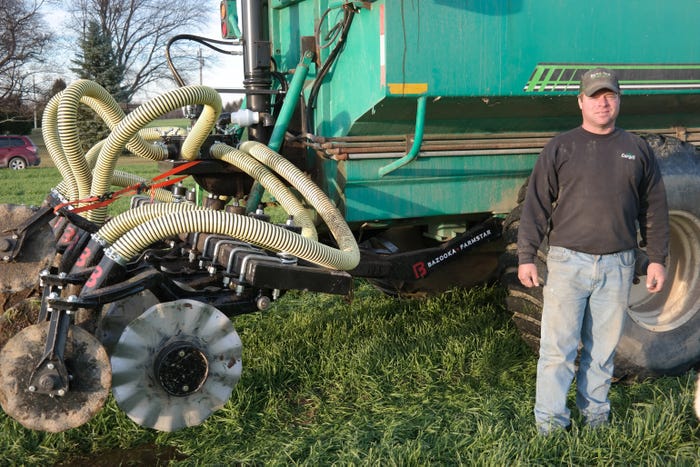
Applying manure in spring is a rite of passage in the Northeast. But spring-applied manure can release nitrates well after spring planting and through silage harvest in the fall, which leads to nutrient leaching into waterways.
Tom Kilcer of Advanced Ag Systems thinks he has a solution: Injecting manure into winter forage when the soil is colder to save nitrogen the following spring and get a high-quality feed for animals.
Previous work by Kilcer and Cornell researchers has shown that applying manure before winter forage planting can meet the nitrogen needs of the forage — in this case triticale — the following spring.
But it doesn’t meet the forage crude protein goal of greater than 18%, and the timing of getting the forage into the ground, right as corn silage is coming off, can be tricky.
A continuation of the research in fall of 2017 was funded by the New York Farm Viability Institute. Kilcer and the other researchers continued applying manure before planting forage, but they also injected manure into the forage in November when the soil temperature was below 50 degrees for the ammonia to be stored until next spring.
Wavy injector coulters
Researchers used a Bazooka Farmstar manure injector with an angled wavy coulter opener to inject the manure. They injected 8,000 gallons an acre on Nov. 20 into forage growing at Brian Chittenden’s Dutch Hollow Farm in Schodack Landing.
 CHITTENDEN FARM: Researchers injected 8,000 gallons an acre into forage growing at Brian Chittenden’s Dutch Hollow Farm in Schodack Landing.
CHITTENDEN FARM: Researchers injected 8,000 gallons an acre into forage growing at Brian Chittenden’s Dutch Hollow Farm in Schodack Landing.

"This unit’s angled wavy coulter lifted the sod with minimal smearing, injected the manure and laid the winter forage sod back down on top of it," Kilcer wrote in a September newsletter. "In one test we applied 14,000 gallons an acre into a harvested corn silage field of heavy, silty clay loam. The next morning the slot only had slight manure residue as the liquid rapidly absorbed into the undisturbed side walls of the trench. The closing coulters did not push the winter forage sod flat. I would suggest you remove them and simply wait 24 hours for it to absorb, then quickly and efficiently run a roller over the field."
Researchers evaluated the effects of additional nitrogen in the spring on plots with preplant manure injections in September; preplant manure injections and an additional injection in November; manure application in November after late forage plantings in October; and injected manure in November on early planted forage. There was also a plot with no manure injected.
The amounts of manure were 8,000 gallons in the preplant plots and 8,000 gallons in the November applications. Manure was injected 3-4 inches into the ground.
The next spring, researchers applied varying rates of synthetic nitrogen fertilizer at 0, 30, 60, 90 and 120 pounds an acre.
November plots promising
"For nonmanured planted on-time plots, 30 pounds of nitrogen an acre was needed for yield. For crude protein, 90 pounds was significantly higher. Manure incorporated before planting on time (September) met all the nitrogen needs for yield the next spring while 90 pounds was best for crude protein production," Kilcer writes.
The most promising results, though, were the November manure injections in early planted forage.
"Planting early with manure side-dressed in November gave us the highest yields and all crude protein was over 17%, although it increases with 60 pounds of spring nitrogen," he writes. "Applying manure before planting and then again in November met all the nitrogen needs for yield except for 60 pounds an acre, which had a fluke low yield affecting the data. Again, all crude protein was above 17%, although significant increases were obtained by adding another 30 pounds of nitrogen an acre in spring."
The October forage plantings with side-dressed manure in November produced the lowest tons of dry matter per acre. An additional 30 pounds of nitrogen was needed to produce greater than 18% percent crude protein.
Kilcer says the study produced promising results, especially in the plots where early planted forage responded well to side-dressing of manure in November. He says prior research has shown that getting the plant into the ground as soon as possible is as crucial to spring yields as any additional manure application helps to boost fall tillers and can reduce the amount of spring-applied nitrogen.
More manure likely needed
Still, there are some caveats to this study. Kilcer says yields were limited to 2.5 tons of dry matter per acre because of using an older planter. That’s important, he says, because a trial next to it that was planted with modern equipment yielded 3.78 tons of dry matter at 19% crude protein, and the amount of nitrogen removed by the plants was much higher. Kilcer says this means the manure rates were likely too low to reflect the amount of nitrogen that would be taken up by triticale in the spring.
He also says the injector, which was on 18-inch centers, would be better at 15-inch centers for more uniform application.
But Kilcer is encouraged by the results.
"We get all the environmental benefits and really produce a high-quality forage," he says.
About the Author(s)
You May Also Like






